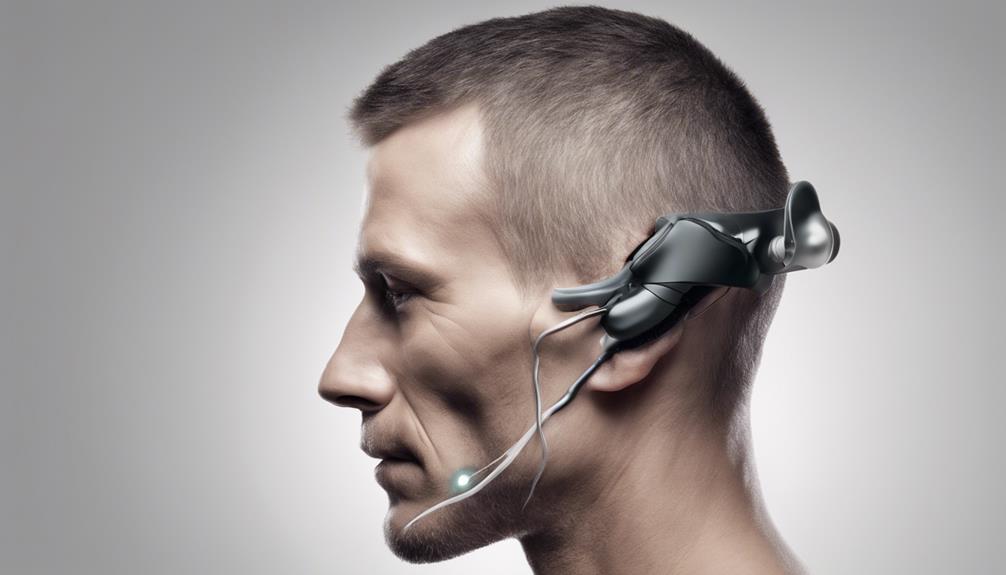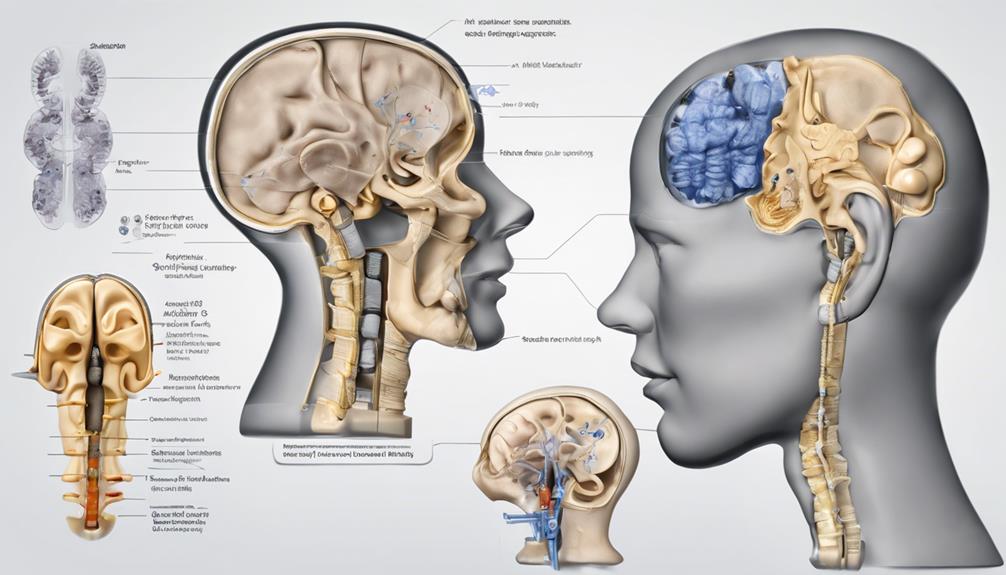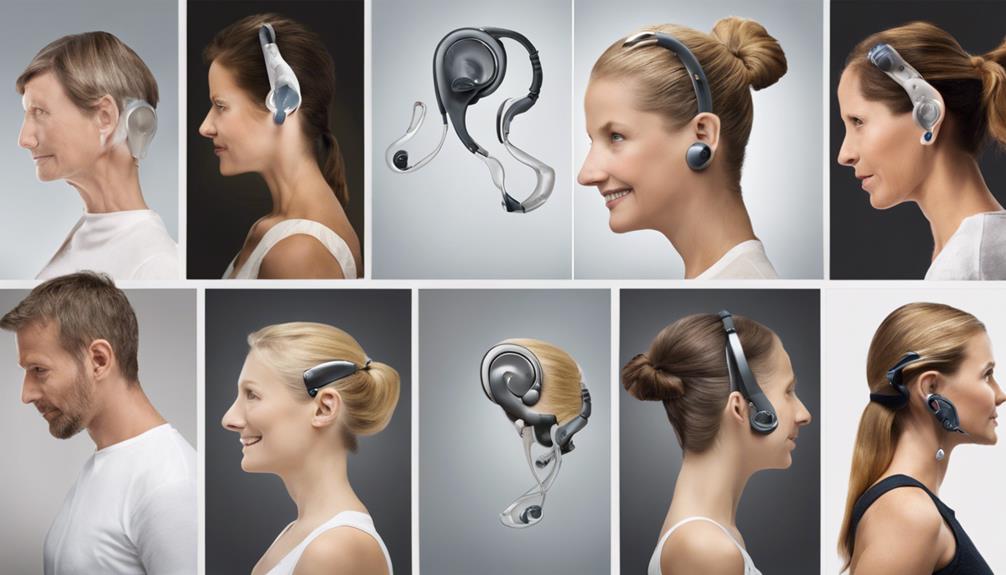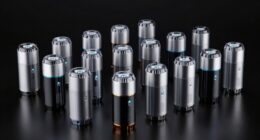When it comes to finding the right hearing aid, there are many different options available to help improve your hearing experience.
Understanding the symphony of five types of cochlear implants isn't just about selecting an option; it's about orchestrating a harmonious blend of technology and individual needs.
With each type designed to address distinct challenges, the journey towards improved sound perception begins with unraveling the nuances of these implants.
Let's explore how these innovations could compose a brighter future for those seeking to bridge the gap between silence and sound.
Key Takeaways
- Traditional Cochlear Implants benefit those with severe to profound hearing loss, stimulating the auditory nerve for improved communication.
- Bone Conduction Implants offer an alternative for individuals with outer or middle ear sound conduction issues, transmitting sound through skull bones.
- Middle Ear Implants address outer or middle ear impairments, enhancing auditory perception for those who can't benefit from traditional aids.
- Auditory Brainstem Implants directly stimulate the brainstem for individuals with hearing nerve function problems, providing auditory perception when cochlear implants are not suitable.
Traditional Cochlear Implants
Traditional cochlear implants, comprising an external microphone and speech processor, deliver signals to an internal receiver/stimulator and electrode array situated within the cochlea. These implants serve individuals with severe to profound hearing loss, enhancing their perception of sound and understanding of speech. By stimulating the auditory nerve, the electrode array enables the brain to interpret these signals, facilitating better communication abilities.
Since their introduction in the 1980s, technological advancements have significantly improved speech recognition and overall quality of life for recipients of traditional cochlear implants. Globally, over 736,900 individuals have benefitted from these devices, experiencing enhanced auditory experiences and communication skills.
With a focus on assisting those with significant hearing impairment, traditional cochlear implants continue to play a crucial role in bridging the gap for individuals seeking to reconnect with the world of sound and speech.
Bone Conduction Implants

Bone conduction implants offer a beneficial alternative for individuals facing outer or middle ear sound conduction issues, providing a solution for those unable to use traditional hearing aids due to ear problems. These implants are particularly suitable for individuals with single-sided deafness, allowing sound to be conducted through the skull bone to the functioning inner ear.
Unlike traditional hearing aids, bone conduction implants reduce the risk of infections or skin problems as they bypass the outer and middle ear. Users of bone conduction implants don't require ear molds, making them a comfortable and convenient option for those who struggle with traditional devices.
Middle Ear Implants
Middle ear implants, consisting of internal and external components, are innovative devices designed to address hearing issues in individuals with outer or middle ear impairments. These implants provide an alternative solution for those who can't benefit from traditional hearing aids due to specific issues in sound conduction within the middle ear.
Here are some key points to consider about middle ear implants:
- Middle ear implants are suitable for individuals who face challenges with traditional hearing aids.
- The internal and external components work together to stimulate the inner ear, enhancing auditory perception.
- Surgically implanted receiver packages help transmit sound through the natural hearing pathway.
- Consulting with audiologists and ENT specialists is crucial in determining the suitability of middle ear implants for individual hearing needs.
- Middle ear implants offer a tailored approach to addressing hearing impairments, focusing on improving sound conduction within the middle ear.
Auditory Brainstem Implants

Individuals who aren't suitable candidates for cochlear implants due to hearing nerve function problems may benefit from Auditory Brainstem Implants. These implants bypass the cochlea and directly stimulate the brainstem to assist with hearing. Auditory Brainstem Implants are less common than cochlear implants and are typically used in specific cases where traditional cochlear implants aren't feasible. Due to the complexity of this implant and the need for specialized surgical expertise, it's essential that individuals considering Auditory Brainstem Implants consult with experienced professionals.
One of the key advantages of Auditory Brainstem Implants is their ability to provide auditory perception in individuals who'd not be candidates for cochlear implants. By stimulating the brainstem, these implants offer a potential solution for those facing challenges with their hearing nerve function. While Auditory Brainstem Implants require a different approach and aren't as widely used as cochlear implants, they play a crucial role in addressing hearing loss in certain individuals.
Hybrid Cochlear Implants
Hybrid cochlear implants seamlessly integrate traditional hearing aid features with advanced cochlear implant technology to cater to individuals with specific hearing loss profiles. These implants offer a middle ground solution for those with high-frequency hearing loss and some residual low-frequency hearing.
Here are the key benefits of hybrid cochlear implants:
- Combine benefits of traditional hearing aids and cochlear implant technology.
- Designed for individuals with high-frequency hearing loss and some residual low-frequency hearing.
- Preserve natural hearing while enhancing speech understanding.
- Suitable for those who may not fully benefit from traditional hearing aids or standard cochlear implants.
- Offer a middle ground solution for individuals with specific hearing loss profiles.
Hybrid cochlear implants provide a unique solution by preserving natural hearing while improving speech clarity, making them a valuable option for individuals with specific hearing needs.
Frequently Asked Questions
What Are the Top 3 Cochlear Implants?
We'll highlight the top 3 cochlear implants based on popularity and features.
Cochlear Nucleus® and Kanso® are renowned choices for their advanced technology.
Advanced Bionics Naída CI, Neptune, and Harmony systems stand out for their innovative features.
Each brand offers unique benefits like waterproof capabilities and user-friendly designs.
Individuals can select the best implant that suits their needs and lifestyle preferences from a range of options in the market.
What Are the Different Types of Cochlear Implants?
We'll delve into the different types of cochlear implants. These devices vary in design, from behind-the-ear options for convenience to body-worn implants offering flexibility in placement.
Off-the-ear models provide a discreet choice, while hybrid implants combine electric and acoustic stimulation for clearer speech understanding. Waterproof implants like the Advanced Bionics Neptune allow for aquatic activities without removal.
Each type serves unique needs, ensuring individuals find the best fit for their lifestyle.
What Are the 3 Criteria for Qualifying for a Cochlear Implant?
To qualify for a cochlear implant, three criteria are essential:
- severe to profound hearing loss in both ears,
- limited benefit from hearing aids, and
- good overall health for surgery.
Realistic expectations, commitment to follow-up care, and willingness to engage in rehabilitation programs are also crucial factors.
These requirements ensure successful candidacy and optimal outcomes for individuals considering cochlear implantation.
What Type of Hearing Loss Is Best for Cochlear Implants?
When it comes to cochlear implants, the best type of hearing loss for this technology is severe to profound sensorineural hearing loss.
These implants are a game-changer for individuals who struggle even with powerful hearing aids.
They can significantly improve speech comprehension, especially in noisy environments.
Candidates with congenital or acquired hearing loss may qualify for cochlear implants based on their specific needs, offering them a chance to experience enhanced speech understanding.
Conclusion
In conclusion, knowing the different types of cochlear implants can greatly impact the quality of life for individuals with hearing loss.
Did you know that over 324,000 cochlear implants have been implanted worldwide as of 2020?
Understanding the options available can help individuals make informed decisions about their hearing health and improve their ability to communicate effectively.
Consult with an audiologist to explore the best implant option for your specific needs.











